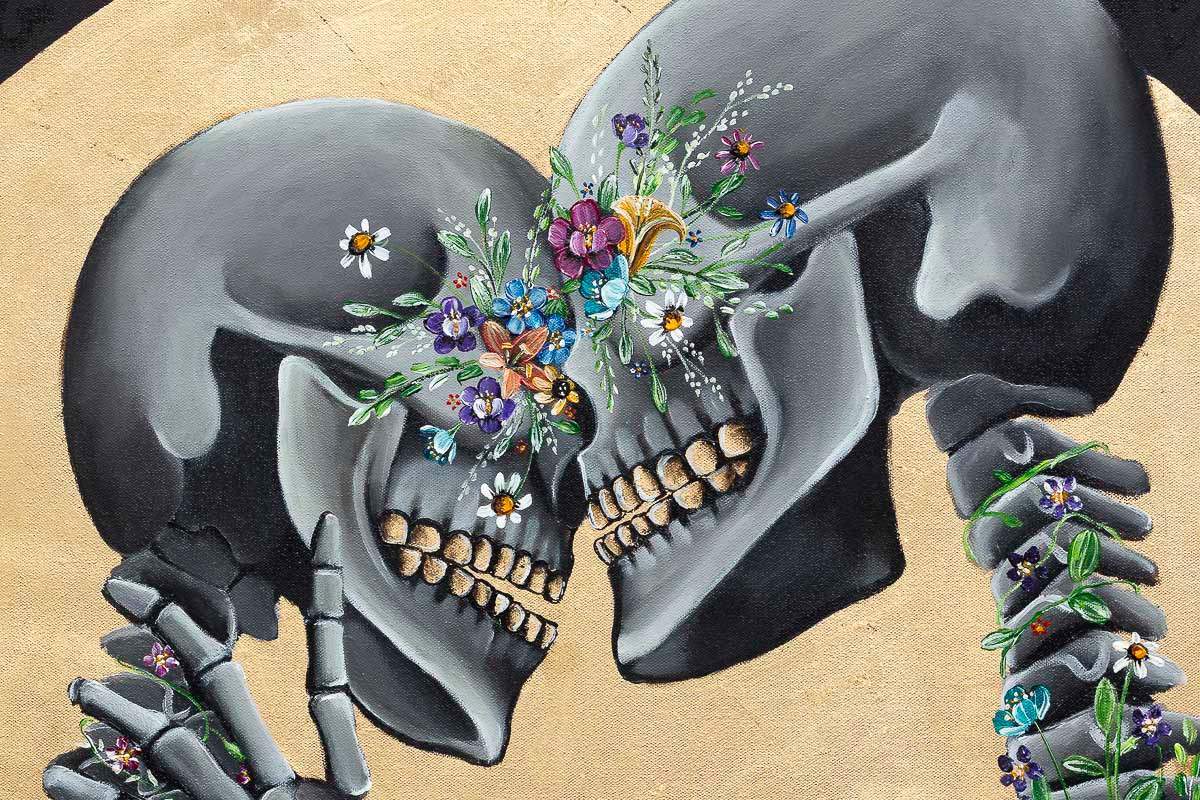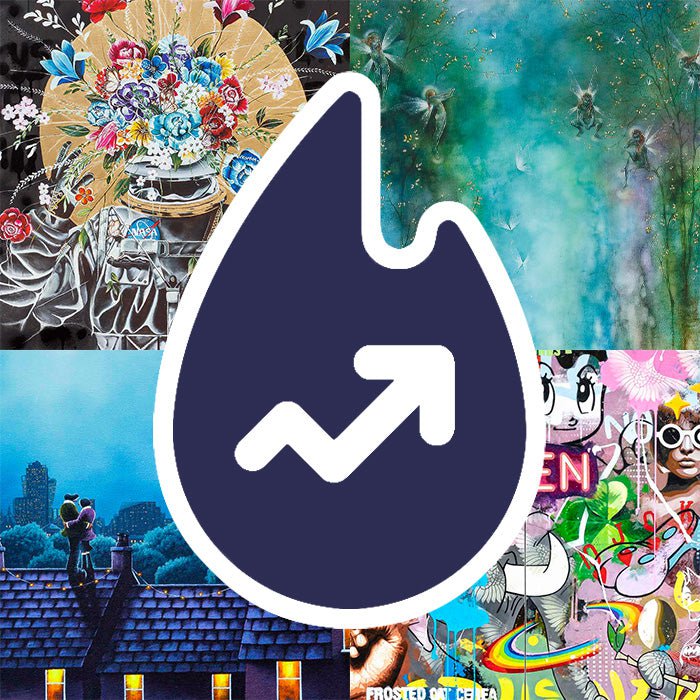With his thrillingly pure abstract originals and idiosyncratic style: it'll come as no surprise that Allan Storer has had a rich and colourful life - in our exclusive interview we discover the career and influences that have shaped this most distinctive of artists.
How did you arrive at such a distinctive style, using depth of colour, interplay of shade – it feels sometimes like the paint itself is your subject matter?
Oil paint is organic and sensuous. My initial empathies are with artists Kyffin Williams and Frank Auerbach and later the squeegee techniques of Gerhard Richter. In common with these artists I am interested in exploring the innate qualities oil presents when exploring the dictum 'truth to material'.
I am fascinated by the sensual and emotional opportunity by way of response that thick impasto oil paint offers to both viewer and artist as a medium responsible for its own reality as contrasted to an imitated reality of an artificial world beyond.
Abstract Art challenges the whole concept of artistic truth and my focus is to channel an emotion or energy, not to deliver a personal message or tell anyone what to think. I do not wish to be the author of a particular viewpoint. The viewer to say "Ah, that is a house, or a field or a London street” My paintings are not representations of a material reality. I just want them to connect... To everyday expectation, my work is meaningless and illogical with no single meaning or viewpoint.
I'm in tune with Professor Jung here when he writes that we humans create banality by our insistence in attaching meaning to every experience or object we encounter. Meaning is therefore derived from limited human experience. There has to be more and I want to give the viewer opportunity to respond to the painting on any emotional level they feel at that one moment when they feel the way they feel at that moment. “Only connect”!
What is your background, how did you become a painter?
My midland childhood is more ‘Peeky Blunders’ than ‘Peeky Blinders’! Initially not the son my father could warm to, I begin my adolescence in a Derby village with a hundred laying hens and a few cockerels on a plot of land donated by my veteran Somme Grandfather… I was going to be a farmer! Derby Cattle Market with ancient farmer Palmer, a fleeting romance with a gypsy girl Margaret, tales around the camp fire, enrollment at Agriculture College and my destiny was sorted… Until a fascination with mythical Cornwall, smugglers, sea horses and surf.
“
My whole being was seeking for something still unknown which might confer meaning upon the banality of life...
- Carl Jung
I’m in my late teens, have a car and tent and make an accidental landing in St. Ives with a female above my then station; complete with drawing book and lurking paintbrush. Everyone who wanted to be a painter was there and I was there too, but only for too short a time - I needed the city life!
Seven years in college made Art and the creative process the tools of my trade. Catapulting me through theatre, parentis locus in an International College, teaching and therapeutic work in both mental health and education.
This series of happy accidents is how I became a full time painter – along with the affirmation of people who liked what I did.
You travel across the UK a lot of Cornwall particularly. Do you find any difference in the way you paint when you are outside of London?
Yes is the simple answer. Artists have been attracted to St. Ives pure light and clean air for generations; with its rugged coastline and elemental ferocity. Whether I’m catching Porthmeor’s surf (I’m a basic surfer) or walking the cliff tops to Zennor, the energy and zest I feel to paint is inevitable.
As do most artists, notably back in the second world war years when When Barbara Hepworth and Ben Nicholson along with a group of collaborators moved there to avoid London bombing raids: Exchanging ideas with abstract artists like Rothko and Pollock across the Atlantic.
Zennor Cliffs. Photo by Tom Oates
Another influence, retired seaman and self-taught naïve artist Alfred Wallis’ instinctual and simplistic approach clears my busy City thought process. Minimalism and honesty are to the fore in St. Ives and the added bonus of pure light enriches my palette, sometimes with clean bright pigments and others with soft pastel greys.
Whilst in Cornwall and South Wales where I also work, I paint en plein air. In London I paint in my studio. There are advantages and disadvantages to both: weather conditions, the wind and rain frequently see my wet painted canvases blow over into the sand adding even more texture to their impasto oil surfaces and an appreciated authenticity for the eventual owner.
By contrast, painting in my cell-like London studio I am enclosed; detached from the elements. There is no natural light and nothing external to influence me – it’s me and myself! Highly subjective, locked-in with canvas and paint; an intensity assisted with the advantage of daylight lighting. My working conditions are constant, giving me more time for reflection, though less feeling for bright colours.
I’ve heard to catch the London feeling, artist Lucien Freud added a touch of charcoal dust to his oil paint to dirty them a little. I can tackle much larger canvases in my studio, a mean average is 140cm x 140cm though the largest painting I executed was 240cm x 750cm and that was for a show apartment by a national building contractor in a Chelsea development.
“
You have to systematically create confusion, it sets creativity free. Everything that is contradictory creates life
- Salvador Dali
You love surrealist work, does that passion inspire your work in any way?
Yes, I think it does, not in an obvious way. A key element of surrealist ideology is 'objective chance'. and I guess I apply this subconsciously when painting.
Surrealist artist Max Ernst use to place paper over bare floorboards and rub over the surface until a significant image made itself visible. Ernst then used or transformed this image into a work of art. He called it ‘Inspiration to Order’. Similarly I begin by painting fairly representational shapes on to canvas using only the primaries and then deliberately rub or scrape into these images to create a mess… Then I climb out of the mess! This is the difficult part.
Striving to avoid a muddy and boring palette I make a series of strokes using brushes, palette knives and my squeegee to create harmony or balance of sorts, listening to music, possibly an inner voice waiting for the paint to begin its conversation with me, to tell where it and I are going. It is a partnership assisted along with a few happy accidents which I allow to remain. Like Max Ernst, I am bringing inspiration to order, though more interested in the aesthetic than figurative.
As do surrealists; I am challenging an everyday reality of the interpreted ‘norm’ requesting the viewer is aware of the ‘now’ their own realty and consciousness. Why? Because I’m asking for an interpretation and not dictating.

















